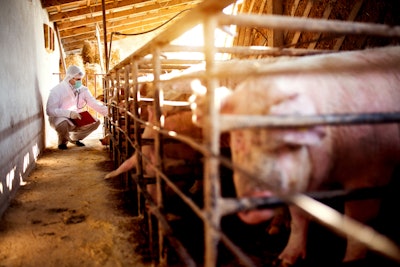
Artificial intelligence (AI) could help wipe out the porcine reproductive and respiratory syndrome (PRRS) virus, according to new research spearheaded by the University of Connecticut.
Researchers at the university used AI to screen some 4 million small molecules for their potential efficacy against PRRS viruses, eventually identifying one chemical that appears to have a 100% success rate in preventing the virus from infecting cells — although the team still needs to test the drug in pigs to verify the results.
Vaccines for PRRS exist, but the PRRS virus mutates frequently, which reduces vaccine efficacy. This drug could prevent infection with PRRS by binding to proteins on cells that act like “gates” through which the virus enters, according to Jiaqi Zhu, a postdoctoral research associate at the University of Connecticut and the lead author on the paper.
Unlike vaccines, the drug wouldn't confer long-term protection against the virus, said Cindy Tian, a University of Connecticut professor of biotechnology. Like most drugs, the liver will eventually clear the molecule from the pigs' system, she said. But the drug could be used in the event of PRRS outbreaks to prevent further spread of the virus to healthy pigs or to neighboring farms.
There's also some chance, Tian said, that the virus would mutate in ways that would allow it to evade the drug. But with a system now in place for the identification of drugs to treat PRRS, it should be possible to find alternatives in the event the virus adapts, she said.
Developing that process, Zhu said, took about eight months from start to finish, with researchers initially identifying the receptor protein they planned to target and then using artificial intelligence to search for molecules that could fit the protein in a manner similar to locks and keys. They then used an AI developed by California-based tech-enabled drug discovery company Atomwise to identify 74 candidates, though most were quickly eliminated after laboratory tests showed they were toxic to living cells. Eventually, they narrowed it down to the most promising candidate — but this process shouldn't take a full eight months in the future, Tian said. The AI has already identified 96 similar molecules that could be used to create new versions of the drug.
Laboratory tests in which researchers tried to infect cells with the PRRS virus showed that the drug was 100% effective in preventing infection, even at relatively low doses. The University of Connecticut plans to conduct animal trials to verify its findings — and is pursuing funding in order to commercialize the drug.
The molecule identified has no known uses and so must essentially be made to order for the time being, but commercial-scale production would presumably help bring down the cost of the drug, Tian said.














